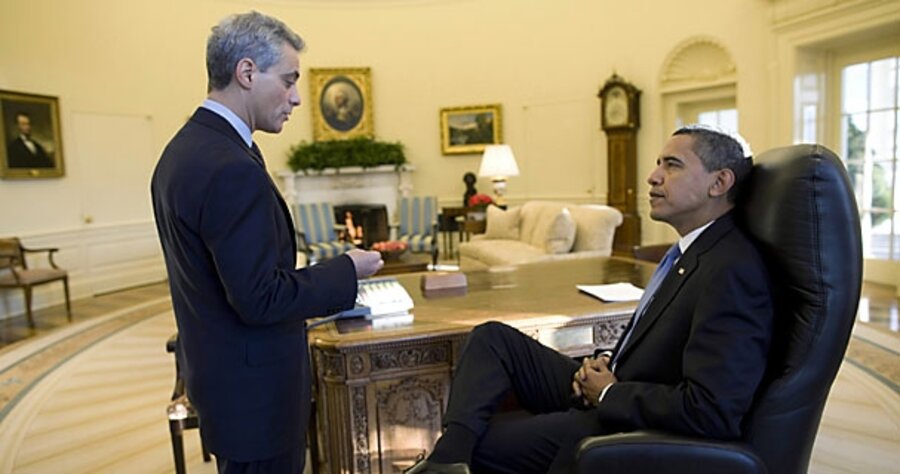Obama's first big moves
Loading...
| Washington
In just a few days, President Obama has sent a series of signals to the nation, seeking to demonstrate that he is in charge and that change, in fact, has arrived.
On Thursday, one of his oft-repeated campaign pledges – that he would close the US’s infamous Guantánamo Bay detention facility – seemed closer to fruition.
Mr. Obama signed an executive order setting in motion the closure of the camp within 12 months. The facility, which houses detainees in the war on terror, has damaged America’s image in the world, a blow Obama hopes to remedy.
Obama also ordered the CIA to close its network of secret prisons.
After the pomp and pageantry of Inauguration Day, Obama’s first steps as president carried an air of symbolism. He froze the pay of his senior White House staff, a gesture toward a nation suffering economically. He also retook the oath of office, after Chief Justice John Roberts flubbed his lines on Tuesday. With the blogosphere and cable TV abuzz with questions over Obama’s full legitimacy as president, the White House decided, out of an “abundance of caution,” that a do-over made sense.
But, keenly aware that his first acts as president would take an outsize place in the history books and set the tone of his tenure, Obama also took actions that supporters applauded for their substance.
Two executive orders on Day 1 tightened ethics rules for administration officials and instituted new rules promoting transparency in government actions. Obama also placed phone calls to key leaders in the Arab-Israeli dispute, signaling a new focus after the Bush years. In the afternoon, he met with his economic and security teams.
He and his wife, Michelle, also found the time to hold the traditional open house at 1600 Pennsylvania Avenue for members of the public. And the Obamas attended the National Prayer Service, another obligatory stop on Day 1.
But it was the breakneck pace of Obama’s first few days, that blend of symbol and substance, that characterized the start of his presidency.
“He wants to show momentum,” says Steven Schier, a political scientist at Carleton College in Northfield, Minn. “Part of it is that the politics of the situation require an active day. But the other thing to note is the huge number of problems he has to deal with.”
With the economy heading downward and the nation at war, the transition to Obama has the feel of a baton pass during a relay race, only with the handoff going to a different team.
The last time a presidential transition took place with so much happening in both domestic and foreign affairs was in 1981. President Reagan took office just as the Iranian hostages were being released, tensions with the Soviets were high over the nuclear threat and their occupation of Afghanistan, and the economy was in a recession, notes Mr. Schier.
Already, some hallmarks of Obama’s leadership style are evident. As was clear during the campaign, Obama is a planner, and he exudes the calm of someone who has thought through how he wants events to unfold.
“He sees how the pieces fit together, and I think that’s been pretty clear in the transition; they’ve got a plan,” says Cal Jillson, a presidential scholar at the Southern Methodist University in Dallas.
Clearly, Mr. Jillson adds, this isn’t just Obama sitting down with a yellow pad and sketching out a game plan.
“There’s a back office group that really is seeing pretty far down the road, and tiering the decisions in a way that allows people to see how things will accumulate,” Jillson says.
Of course, not all goes according to plan. His nominee for Commerce secretary, New Mexico Gov. Bill Richardson, withdrew his name after reports were published of a federal investigation into a political donor’s receipt of a state contract. Obama has yet to name a replacement.
Two of Obama’s other nominees have hit snags. Timothy Geithner, tapped to run Treasury, was caught owing back taxes. And Eric Holder, nominated for attorney general, has faced sharp questions over a controversial pardon at the end of the Clinton administration.
Mr. Geithner was endorsed by the Senate Finance Committee Thursday. Senate Republicans have delayed a vote on Mr. Holder’s nomination until next week.
In the end, Obama is expected to get who he wants at Treasury and Justice, especially given the state of the economy and the complicated legal matters surrounding detainees in the war on terror.
In a way, Obama has shown himself to be similar to Bush. The now-ex-president relished bold actions, seeing the presidency as a vehicle for consequential steps, not incrementalism.
Obama, too, has already begun working down the to-do list of campaign promises in bold strokes.
And he appears well aware that, at the start of his presidency, he may be at the height of his political capital. Nearly 8 in 10 Americans view him favorably, and hopes are high that he can turn around the economy, fix the healthcare system, and get the US out of Iraq responsibly.
The first year will be critical. At some point, he will own the problems he has inherited, and so time is of the essence.





